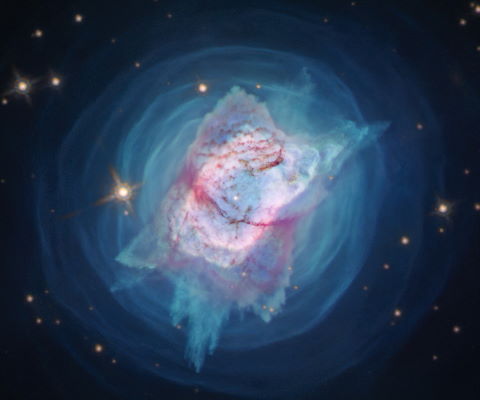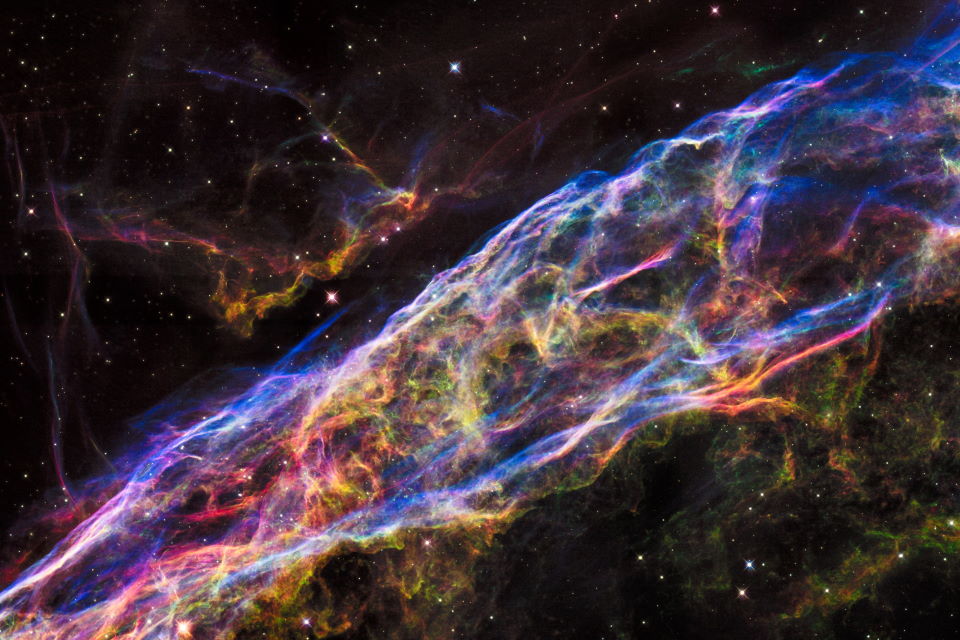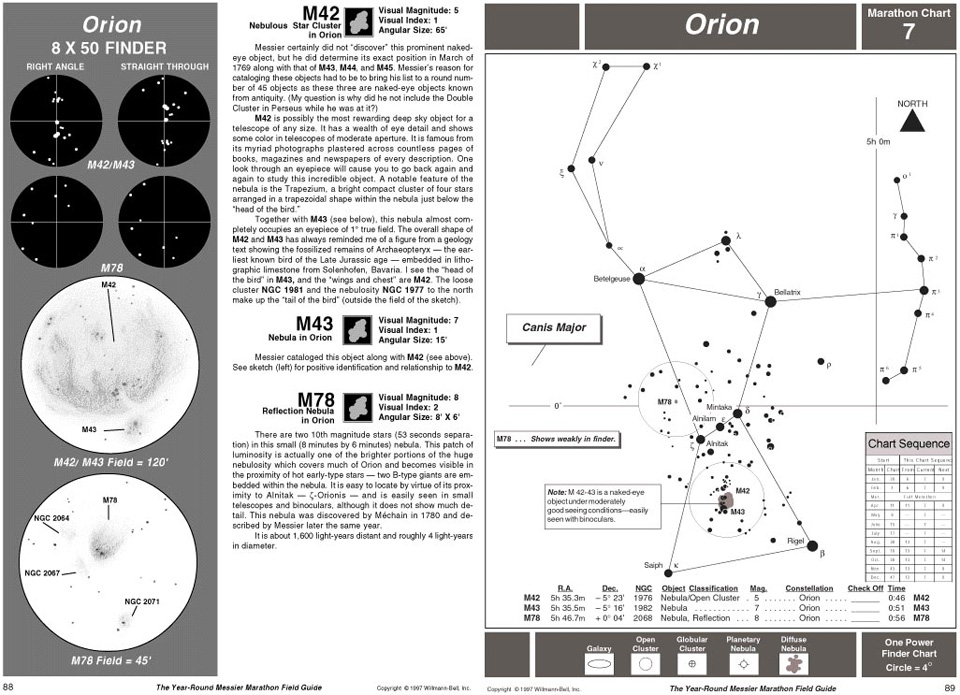Introduction
By no means complete, August's mini guide that follows provides notes for exploring various interesting deep sky objects (DSOs) and lists other items of interest useful to the amateur astronomer.
Entries can be interpreted based on designation, description and magnitude as follows.
Designation – Description – Magnitude:
★ Telescopes 10-inch aperture minimum.
★★ Telescopes 6-inch to 9-inch aperture.
★★★ Binoculars (50mm+ aperture) and telescopes
3-inch to 5-inch aperture.
A collimated instrument, favourable atmospheric conditions, dark skies and dark-adapted eyes are assumed.

NGC 7027 planetary nebula.
Credit: NASA, ESA, and J. Kastner (RIT).
About NGC 7027 planetary nebula
This image from the Hubble Space Telescope depicts a young planetary nebula, NGC 7027, which resembles a jewel bug. It is among the dustiest planetary nebulae known and contains unusually large masses of gas.
Credit: NASA, ESA, and J. Kastner (RIT).
| August deep sky objects |
| Cepheus constellation |
|
NGC188
|
Open cluster close to Polaris.
|
8.1
|
★★
|
|
NGC6946
|
Face-on galaxy close to the NGC6939 open cluster. Being in same field of view, the two galaxies offer themselves to CCD imaging. Appears as pale glow in smaller instruments but will reveal its structure in large instruments.
|
9.66
|
★★
|
|
NGC7023
|
Bright reflection nebula viewed in medium size instruments. Larger instruments are needed to reveal its structure.
|
7.1
|
★★
|
|
NGC7129
|
The Small Cluster Nebula consists of a faint reflection nebula and a star cluster. Visible in moderate size instruments.
|
12.0
|
★★
|
| Equuleus constellation |
|
NGC7040
|
Large instruments will be required to view this galaxy.
|
14.9
|
★
|
|
IC1360
|
Spiral galaxy situated near the Celestial equator.
|
15.3
|
★
|
| Lacetra constellation |
|
NGC7243
|
Open cluster with around 40 members.
|
6.40
|
★★
|
|
NGC7245
|
Open cluster, hard to pick out.
|
7.50
|
★
|
| Cygnus constellation |
|
M39
|
A large but sparse open cluster. Binoculars will resolve around 10 stars. Because of its large apparent size it is better viewed at low magnifications.
|
4.6
|
★★
|
|
NGC6866
|
Open cluster visible in binoculars.
|
5.50
|
★★★
|
|
NGC7000
|
The American Nebula is a huge emission nebula visible to the unaided eye under dark skies. It is better viewed in large binoculars and at low magnifications. Nebular filters will enhance the view.
|
7.0
|
★★
|
|
NGC7027
|
Bright Planetary nebula. A medium size instrument at high magnifications will show a small blue/green oval with a diffuse perimeter.
|
10.4
|
★★
|
|
IC5146
|
Open cluster visible in larger instruments.
|
7.2
|
★
|
| Pegasus constellation |
|
M15
|
Bright and compact cluster visible in binoculars as a bight patch. Larger instruments will resolve stars in its periphery and some of the brighter stars located in the centre.
|
2.4
|
★★★
|
| Capricorn constellation |
|
M30
|
A brighter cluster with a dense core surrounded by a large halo of stars. Stays close to the Horizon and is therefore more difficult to observe.
|
8.50
|
★★
|
| Aquarius constellation |
|
NGC7009
|
The Saturn Nebula that resembles the shape of Saturn is an apparently small nebula that will take magnification well but in binoculars it is difficult to distinguish from a star. Large instruments are required to bring out its Saturn like shape and pale green colour.
|
8.30
|
★★★
|
|
NGC7293
|
The Helix Nebula is an apparently large planetary nebula but with low surface brightness. It is better observed at low magnifications. It will also show in large binoculars.
|
6.50
|
★★
|
| Cygnus constellation |
|
NGC6960
|
The Veil Nebula is a remnant of a supernova explosion and appears as a loose broken ring of gaseous filaments. The NGC960 is one of the two most prominent parts and is the easier to view. Under dark skies it may be visible in large binoculars. It will benefit from large apertures and the use of filters.
|
7.0
|
★★
|
|
NGC6992
|
The Veil Nebula is a remnant of a supernova explosion and appears as a loose broken ring of gaseous filaments. The NGC9692 is one of the two most prominent parts. Under dark skies it may be visible in large binoculars. It will benefit from large apertures and the use of filters.
|
7.0
|
★★
|
|
NGC6888
|
The Crescent nebula is a diffuse nebula. Filters will enhance the view.
|
10.0
|
★★
|
| Vulpecula constellation |
|
NGC6940
|
Open cluster over a rich star field. Visible in binoculars it will resolve in moderate size instruments.
|
6.50
|
★★★
|
| Aquarius constellation |
|
M2
|
Globular cluster with around 100,000 members in a relatively dark part of the sky. Visible in binoculars. Larger instruments will resolve some of the peripheral stars.
|
7.50
|
★★★
|
|
M72
|
Open but faint cluster. Visible in binoculars it will resolve in larger instruments.
|
10.0
|
★★
|
|
M73
|
A group of four stars forming a Y shape. It is not known if these stars are physically or simply visually related.
|
9.0
|
★
|
| Capricorn constellation |
|
NGC6903
|
Galaxy that appears as a faint oval patch of light.
|
12.9
|
★
|
|
NGC6907
|
Galaxy that appears as an oval patch of light showing little detail even in lager instruments.
|
11.9
|
★
|
|
|
Designation, Description, Magnitude
|
★ Telescopes 10-inch aperture minimum.
★★ Telescopes 6-inch to 9-inch aperture.
★★★ Binoculars (50mm+ aperture) and telescopes 3-inch to 5-inch aperture.
|
The night sky
Under excellent conditions over 2,000 stars can be seen with the unaided eye but only a few hundred of these are prominent enough to be useful in navigating the night sky, these are normally included in amateur sky maps and digital planetarium programs like the SkySafari, Stellarium, The Sky, Starry Night, Winstars 2 etc. Some stars will show colour that is useful in identifying them. For example, Antares, Betelgeuse and Aldebaran are orange/red where Vega, Rigel and Spica appear as blue/white.
Stars that form easily recognisable patterns have been given names and are referred to as constellations. Of these, the brightest stars act as beacons and can be used to effectively navigate the night sky during the different months of the year. To that extent stars can be particularly useful in locating other interesting objects nearby normally viewable through binoculars or larger instruments.
Planets and their satellites, comets and meteors move independent of the night sky background and at comparatively high speeds. They are therefore very difficult or impossible to reference to any star. However, planets like Jupiter, Saturn, Venus and Mars as well as the Moon are easy to spot with the unaided eye and in the case of the larger planets and especially the Moon, even medium size binoculars will reveal a limited degree of detail.
NGC 6960 part of Veil nebula
This image shows a small section of the Veil Nebula, as it was observed by the NASA/ESA Hubble Space Telescope. This section of the outer shell of the famous supernova remnant is in a region known as NGC 6960 or — more colloquially — the Witch’s Broom Nebula.
Credit: NASA, ESA, Hubble Heritage Team.

NGC 6960 part of Veil nebula. Credit: NASA, ESA, Hubble Heritage Team.
Sky conditions
The prevailing sky conditions will have a significant effect on what you can see through any instrument and binoculars. As such if you live near a city the light pollution can make it difficult to locate and observe most DSOs. The Moon and a hazy sky will also have a negative effect.
For best results observe from a dark site and under clear transparent skies without the moon being present. Once your eyes have been accustomed to the dark conditions (this takes around 20-30 minutes) you should be able to enjoy the night sky at its best.
Filters
Filters will help to an extent and lager instruments will benefit more from them. Light pollution filters would help and photo-visual UHC (nebula filters) would be worth considering.
Printed aids
A huge number of printed aids exist in terms of deep sky maps and books. An excellent printed guide for people new in astronomy is The Year-Round Messier Marathon Field Guide published by Willmann Bell Inc.
In this large format hard-back book, the author, Harvard Pennington shows how to:
- Learn 17 bright finder stars and 17 prominent finder constellations so you will know where to look for all 110 Messier objects.
- Align a sighting device such as an 8x50 finder scope or the Telrad® so that you can point your instrument rapidly and with assurance toward all of the Messier objects.
- Calibrate your instrument so that you know exactly how much sky you see through your finder and through the eyepiece of your instrument.
- Find all of the Messier objects using the maps, drawings and descriptions in this book. You will know exactly where to point your instrument, and what the object should look like when you find it.

Extract from The Year-Round Messier Marathon Field Guide
published by Willmann Bell Inc.
Related topics:
night sky, deep sky object guide, August



